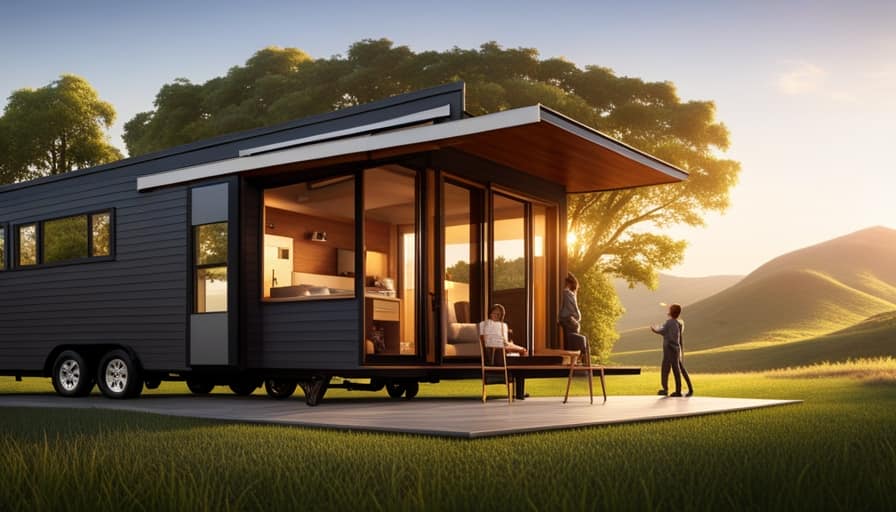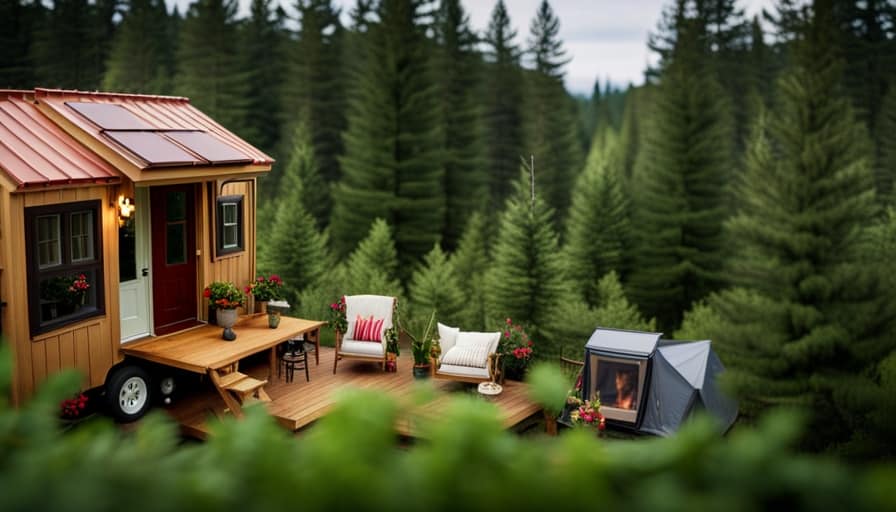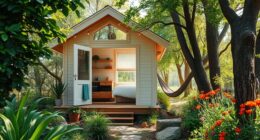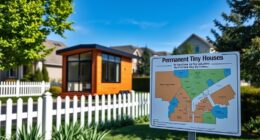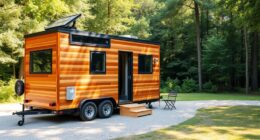Wondering about the safety of residing in a small house? Don’t worry, we’ve got you covered! This article delves into the different structural, electrical, and fire safety factors to consider for tiny houses.
We’ll also discuss the importance of insurance and precautions for towing your tiny house on wheels.
Plus, we’ll provide essential safety measures for day-to-day living in a tiny house.
So, if you’re looking for practical advice on keeping yourself and your tiny home safe, keep reading!

Key Takeaways
- Structural safety considerations, such as using quality materials and regular maintenance, are important for ensuring the safety of living in a tiny house.
- Electrical safety precautions, including proper wiring and grounding, installation of smoke detectors, and following electrical codes, are necessary for a safe living environment in a tiny house.
- Fire prevention and safety measures, such as fire safety training, regular inspections of electrical systems, and maintaining fire extinguishers, are crucial for minimizing fire risks in a tiny house.
- Insurance considerations, such as the importance of tiny house insurance, researching and comparing insurance providers, and practicing safe towing practices, should be taken into account to protect against potential risks and damages.
Structural Safety Considerations
As we explore structural safety considerations, it’s essential to understand the potential risks and precautions associated with living in a tiny house. Safe building practices should be followed to ensure the structural integrity of the house. This includes using quality materials, proper insulation, and sturdy foundation.
Regular maintenance is also crucial to keep the house safe. Inspecting the roof, walls, and flooring for any signs of damage or wear is important. It’s recommended to have a professional check the electrical and plumbing systems periodically to prevent any potential hazards.
Additionally, being mindful of the weight distribution inside the house is crucial. Properly distributing the weight of furniture and belongings can help prevent structural issues and ensure the overall safety of the tiny house.
Electrical Safety Precautions
When it comes to electrical safety in tiny houses, there are two important points to consider: proper wiring and grounding, as well as fire prevention measures.

Ensuring that the electrical system is installed correctly and up to code is crucial in preventing electrical hazards and potential fires.
Additionally, implementing fire prevention measures such as installing smoke detectors, fire extinguishers, and practicing safe electrical usage habits can greatly reduce the risk of accidents in a tiny house.
Proper Wiring and Grounding
We ensure that our tiny houses have proper wiring and grounding for electrical safety precautions. Proper wiring and grounding are essential safety measures in a tiny house to prevent electrical accidents and fire hazards. To guarantee the safety of our residents, we follow industry standards and guidelines for electrical installations. This includes using safe building materials and employing experienced electricians who understand the unique challenges of tiny house electrical systems. Additionally, we conduct regular inspections to ensure that all electrical components are in good working condition. Here are some frequently asked questions and common concerns related to proper wiring and grounding in a tiny house:
| Frequently Asked Questions | Common Concerns |
|---|---|
| How can I prevent electrical fires in my tiny house? | Is it necessary to have tiny house insurance? |
| What are the towing precautions for electrical systems? | Are there any specific safe building materials for electrical installations in a tiny house? |
Fire Prevention Measures
To ensure the safety of our residents, we implement a range of fire prevention measures and electrical safety precautions in our tiny houses.
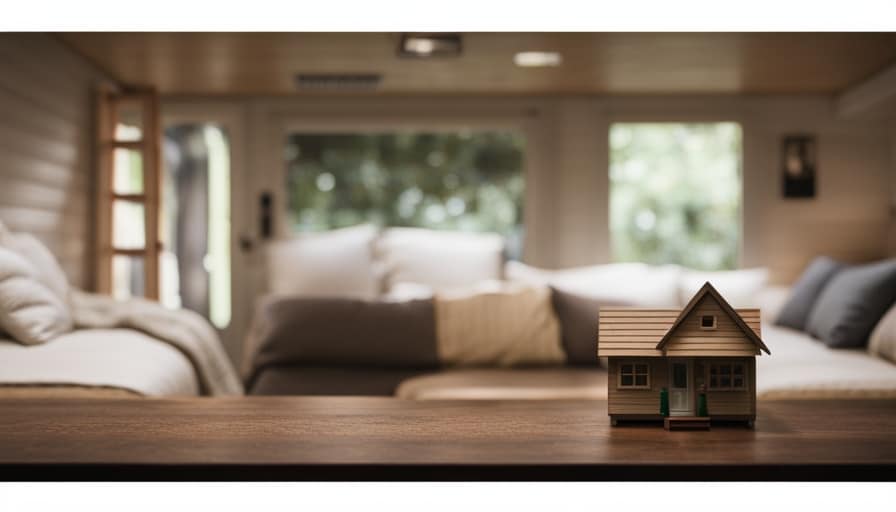
Fire safety training is provided to all residents upon moving in, ensuring they’re equipped with the knowledge to prevent fires and respond appropriately in case of an emergency.
Our houses are equipped with smoke detectors in every room, providing early detection of any potential fire hazards.
Additionally, we conduct regular inspections to ensure proper maintenance of electrical systems, including proper wiring and grounding.
Fire extinguisher maintenance is a top priority, with regular checks and replacements as needed. We also educate our residents on the importance of maintaining their fire extinguishers and provide guidance on how to use them effectively.

Fire Safety Measures for Tiny Houses
When it comes to fire safety in tiny houses, there are several important measures to consider.
First, it’s crucial to have a fire extinguisher readily accessible and properly placed in the house, ensuring that it’s within reach in case of an emergency.
Additionally, smoke alarms should be installed in strategic locations throughout the house to provide early detection of any potential fire hazards.
Lastly, it’s essential to have a well-planned escape route in case of a fire, ensuring that all occupants can safely exit the tiny house in a timely manner.

Fire Extinguisher Placement
We regularly place fire extinguishers throughout our tiny houses to ensure quick and accessible fire safety measures. Fire extinguisher placement is crucial in maintaining the safety of our homes.
According to fire safety regulations, it’s recommended to have at least one fire extinguisher on each level of the house, including the kitchen and sleeping areas. It’s essential to regularly check the fire extinguisher maintenance, ensuring it’s in working condition and not expired.
We suggest placing fire extinguishers in easily accessible areas, such as near exits or main living spaces. It’s also important to educate ourselves and our family members on how to properly use a fire extinguisher in case of an emergency.
Smoke Alarm Installation
Fortunately, smoke alarm installation is a relatively simple and effective way to enhance fire safety in our tiny houses. Here are four key points to consider when it comes to smoke alarm installation:

-
Placement: Install smoke alarms on every level of your tiny house, including inside each sleeping area and outside each sleeping area. Place them on the ceiling or high on the wall, away from corners and vents.
-
Interconnection: Interconnect all smoke alarms so that when one alarm sounds, they all sound. This ensures that everyone in the tiny house is alerted to the presence of smoke or fire.
-
Regular Maintenance: Test your smoke alarms monthly and replace batteries at least once a year. Clean the alarms regularly to remove dust and debris that may interfere with their functionality.
-
Fire Escape Drills: Conduct fire escape drills regularly with everyone living in the tiny house. Make sure everyone knows the escape routes and designated meeting points outside the house.

By following these guidelines, we can ensure that our smoke alarms are properly maintained and that we’re prepared for any fire emergency.
Now let’s move on to the next crucial step: escape route planning.
Escape Route Planning
Let’s start by mapping out our escape routes and implementing fire safety measures in our tiny houses. When it comes to escape route planning, it’s crucial to have multiple exits in case one becomes blocked during a fire.
Consider installing windows that can be easily opened from the inside, as well as a sturdy ladder for quick and safe evacuation.

Additionally, it’s important to use safe building materials that are less likely to catch fire, such as fire-resistant insulation and non-combustible siding. These materials can provide an extra layer of protection and increase the chances of escaping unharmed.
Remember to regularly check and maintain your escape routes to ensure they’re clear and easily accessible.
Importance of Tiny House Insurance
Our tiny house’s insurance coverage is crucial for protecting our investment and ensuring peace of mind. Here are four reasons why having insurance for our tiny house is important:
-
Protection against accidents and damages: Accidents can happen, and damages to our tiny house can be costly to repair. With insurance, we can have financial protection against unexpected events like fire, theft, or natural disasters.

-
Liability coverage: If someone gets injured while visiting our tiny house, our insurance can provide liability coverage, protecting us from potential lawsuits and medical expenses.
-
Coverage for personal belongings: Our tiny house may hold valuable belongings that are subject to loss or damage. Having insurance can help us replace these items, ensuring that we don’t suffer a significant financial loss.
-
Options for different coverage levels: When comparing insurance options, we can choose a policy that fits our specific needs and budget. We can customize coverage to include additional features such as coverage for towing, roadside assistance, and more.
Availability of Tiny House Insurance Options
When it comes to the availability of tiny house insurance options, it’s important to consider the limitations of coverage and the associated costs.

While there are insurance providers that offer coverage specifically for tiny houses, it’s essential to understand what’s included in the policy and what may be excluded.
Additionally, the cost of insurance may vary depending on factors such as location, size of the tiny house, and the level of coverage desired.
Insurance Coverage Limitations
The availability of insurance options for tiny houses can be limited. It’s important for tiny house owners to be aware of the insurance coverage limitations they may face. Here are four key points to consider:
-
Limited providers: Due to the unique nature of tiny houses, not all insurance companies offer coverage specifically for them. It may take some research to find a provider that offers policies tailored to tiny houses.

-
Coverage restrictions: Even if you find an insurance company that offers coverage for tiny houses, there may be limitations on what’s covered. Make sure to carefully review the policy to understand what’s included and excluded.
-
Higher premiums: Insurance premiums for tiny houses can be higher compared to traditional homes. Factors such as the mobility of tiny houses and their vulnerability to damage may contribute to the higher cost.
-
Safe towing precautions: It’s important to follow safe towing practices to minimize the risk of accidents and damage to your tiny house. This includes ensuring proper weight distribution, using appropriate towing equipment, and following all traffic laws.
Understanding these insurance coverage limitations and taking necessary precautions can help tiny house owners protect their investment and have peace of mind.

Cost of Tiny House Insurance
Finding affordable insurance options for tiny houses can be challenging due to their unique characteristics and limited availability. The cost of insurance for tiny houses can vary depending on several factors such as location, size, and construction materials. Insurance companies often consider tiny houses as non-standard or high-risk properties, which can result in higher premiums.
Additionally, insurance coverage limitations may exist for tiny houses, particularly in terms of liability coverage and personal property coverage. It’s important for owners of tiny houses to carefully review their insurance policies to ensure they’ve adequate coverage for any potential risks or damages.
Some insurance companies offer specialized coverage options specifically tailored for tiny houses, but these options may be limited in terms of availability. It’s advisable for tiny house owners to shop around and compare insurance quotes from different providers to find the most suitable and cost-effective coverage.
Safe Building Materials for Tiny Houses
How can we ensure that our tiny houses are built with safe materials?

It’s important to choose safe building materials for our tiny homes to ensure the overall safety and well-being of its occupants. Here are four safe building materials that aren’t only durable but also energy efficient:
-
Non-toxic insulation: Opt for insulation made from natural materials like sheep’s wool or cellulose, which are free from harmful chemicals and provide excellent thermal performance.
-
Low VOC paints: Use paints that have low levels of volatile organic compounds (VOCs) to minimize indoor air pollution and promote better air quality.
-
Formaldehyde-free plywood: Look for plywood that’s free from formaldehyde, a harmful chemical commonly found in building materials, to reduce the risk of respiratory issues.

-
Sustainable flooring options: Consider using eco-friendly flooring materials such as bamboo or cork, which are renewable, durable, and have low environmental impact.
By using these safe building materials, we can create a healthier and more sustainable living environment in our tiny houses.
However, ensuring the safety of our tiny homes doesn’t end with the materials we use. It’s also essential to take precautions for safe towing of tiny houses on wheels (THOW).
Precautions for Safe Towing of Tiny Houses on Wheels (THOW)
We must ensure that we take proper precautions for safe towing of our tiny houses on wheels (THOW) to prevent any accidents or damage while on the road. Two important factors to consider are proper tire maintenance and weight distribution. Maintaining the tires of your THOW is essential for safe towing. Regularly check the tire pressure, tread wear, and overall condition of the tires. It is also crucial to distribute the weight of your THOW evenly to avoid instability during towing. A well-balanced load can be achieved by placing heavier items lower and towards the front of the trailer. Additionally, securing all loose items inside the THOW can prevent them from shifting and causing imbalance. By following these precautions, we can ensure a safe and smooth towing experience for our tiny houses on wheels.
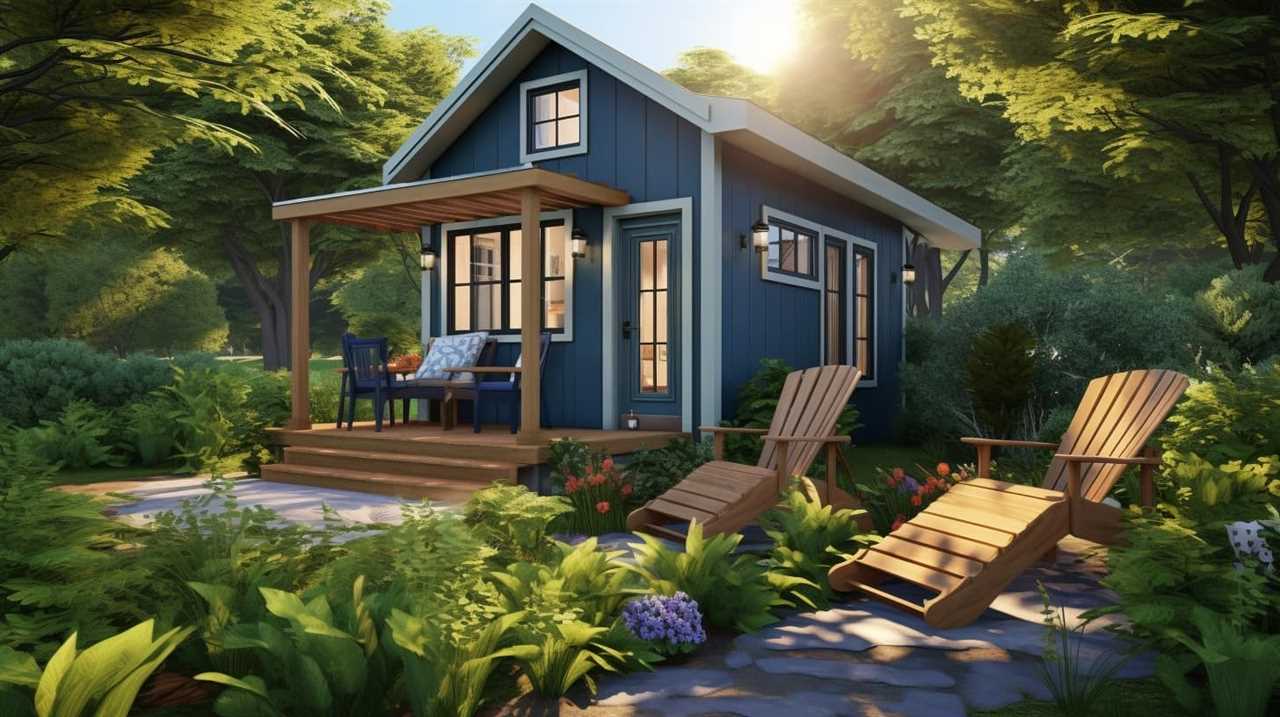
| Proper Tire Maintenance | Weight Distribution |
|---|---|
| Check tire pressure regularly | Distribute weight evenly |
| Inspect tread wear | Place heavier items lower and towards the front |
| Examine overall tire condition | Secure loose items inside THOW |
Essential Safety Measures for Living in a Tiny House
To ensure our safety while living in a tiny house, it’s important that we implement essential measures and remain vigilant. Here are four important tiny house security measures and health and safety considerations to keep in mind:
-
Install a robust security system: Protect your tiny house by installing a reliable security system that includes motion sensor lights, surveillance cameras, and door/window sensors. This will deter potential intruders and provide peace of mind.
-
Have a fire safety plan: Due to limited space, it’s crucial to have a well-thought-out fire safety plan. Install smoke detectors and fire extinguishers in strategic locations, and make sure to regularly test and maintain them. Develop an evacuation plan and ensure everyone in the house is aware of it.
-
Maintain good indoor air quality: Since tiny houses have limited ventilation, it’s important to monitor indoor air quality. Use natural and eco-friendly cleaning products, keep the house well-ventilated, and consider installing an air purifier to remove pollutants and allergens.
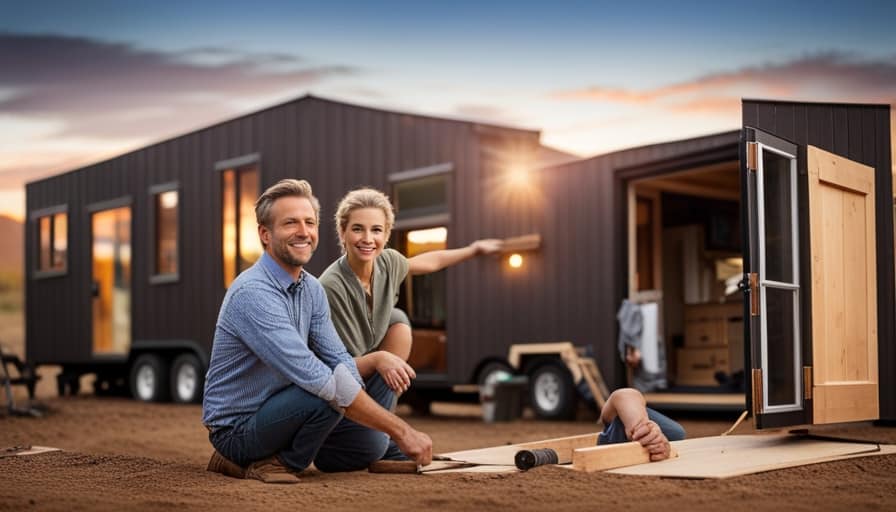
-
Practice proper electrical safety: Tiny houses often have limited electrical capacity, so it’s essential to use appliances and devices that are energy-efficient and don’t overload the electrical system. Regularly inspect and maintain electrical connections, and consider hiring a professional electrician to ensure everything is up to code.
By implementing these tiny house security measures and health and safety considerations, we can create a safe and comfortable living environment.
Now, let’s move on to addressing frequently asked questions about tiny house safety.
Frequently Asked Questions About Tiny House Safety
Before we dive into the frequently asked questions about tiny house safety, let’s address some common concerns regarding the overall safety of living in a tiny house.

Many people wonder if tiny houses are secure and if they provide the same level of safety as traditional homes. While living in a tiny house does come with its own set of considerations, there are several security features that can be incorporated to ensure a safe living environment. These features include sturdy doors and windows, secure locks, and even security systems.
Additionally, there are many benefits to living in a tiny house that contribute to overall safety, such as reduced fire risk due to smaller space, lower utility costs, and the ability to live in a community-oriented environment.
Addressing Common Concerns About Tiny House Safety
When it comes to tiny house safety, we understand that there are several common concerns that need to be addressed. Here are some key points to consider when it comes to fire safety and insurance coverage:
- Fire Safety:
- It’s important to take precautions to prevent fires in a tiny house.
- Install smoke detectors and fire extinguishers.
- Avoid using flammable materials in the construction of your tiny house.
- Keep electrical systems well-maintained and avoid overloading circuits.
- Insurance Coverage:
- It’s crucial to have adequate insurance coverage for your tiny house.
- Talk to your insurance provider about getting coverage specifically tailored for tiny houses.
- Make sure your policy covers fire damage, theft, and liability.
- Safety Measures:
- Implement additional safety measures such as having multiple exits.
- Install carbon monoxide detectors.
- Practice fire drills regularly.
- Regular Inspections:
- Regularly inspect your tiny house for any potential fire hazards.
- Check your electrical systems, propane tanks, and heating sources to ensure they’re in good working condition.
Frequently Asked Questions
Are Tiny Houses Built on Wheels as Safe as Traditional Houses?
Tiny houses built on wheels, like traditional houses, can be safe. Structural stability is crucial, with proper anchoring and quality materials. Fire safety measures, such as smoke detectors and fire extinguishers, should be in place. Regular inspections and maintenance ensure ongoing safety.

What Are the Risks of Living in a Tiny House During Extreme Weather Conditions?
Living in a tiny house during extreme weather conditions poses certain risks. Proper insulation is crucial to maintain a comfortable and safe living environment. It’s important to be prepared and take necessary precautions to ensure our well-being.
How Can I Ensure the Structural Integrity of My Tiny House Over Time?
To ensure the structural integrity of our tiny house over time, we can create a maintenance checklist. Regularly inspecting the foundation, roof, and plumbing, and addressing any issues promptly will help ensure durability and safety.
Are There Any Specific Safety Regulations or Codes That Apply to Tiny Houses?
There are specific safety regulations and codes that apply to tiny houses. It is important to ensure compliance with these regulations to ensure the safety of those living in a tiny house.
What Are the Common Safety Concerns Associated With Living in a Tiny House Community?
Fire safety and security measures are common concerns when living in a tiny house community. It’s important to have smoke detectors, fire extinguishers, and escape plans in place. Additionally, installing security systems and practicing good community safety measures can help ensure a safe living environment.
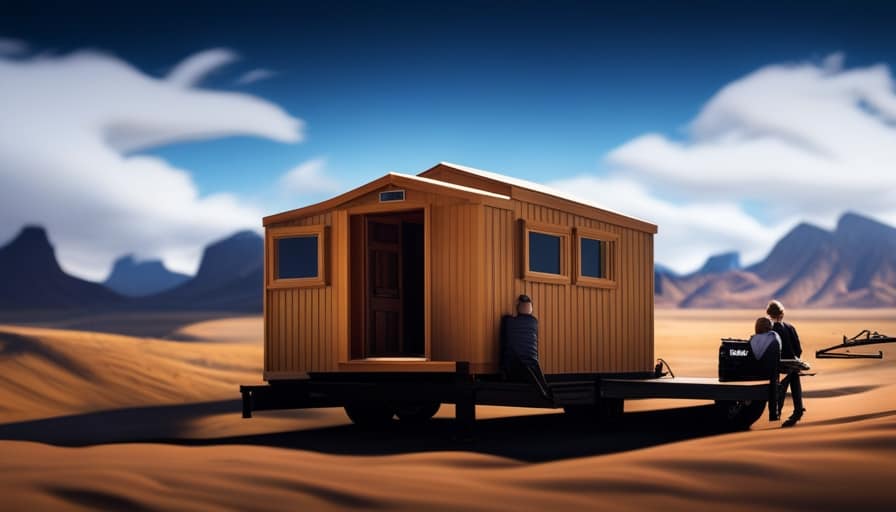
Conclusion
In conclusion, living in a tiny house can be safe if proper precautions are taken.
For example, Sarah and Mark, a couple who built their own tiny house, invested in a comprehensive insurance policy that covered them in case of accidents or damage. This gave them peace of mind and allowed them to fully enjoy their minimalist lifestyle without worrying about potential risks.
By being proactive and taking necessary safety measures, living in a tiny house can be a secure and fulfilling experience.
I’m Theodore, and I love tiny houses. In fact, I’m the author of Tiny House 43, a book about tiny houses that are also tree houses. I think they’re magical places where imaginations can run wild and adventures are just waiting to happen.
While tree houses are often associated with childhood, they can be the perfect adult retreat. They offer a cozy space to relax and unwind, surrounded by nature. And since they’re typically built on stilts or raised platforms, they offer stunning views that traditional homes simply can’t match.
If you’re looking for a unique and romantic getaway, a tree house tiny house might just be the perfect option.



